Now we are going to talk about various topics on phylum Chordata, the definition of Chordata, examples of Chordata, classification of Chordata, origin, and Ancestry of Chordata, diversity of Chordata, similarity, and dissimilarity of Chordata with Non-chordate.
Table of Contents
Definition of Chordata | What is Chordata:
The word Chordata comes from a feature in some animals, notochord, the animals have a notochord and some other fundamental characters are known as Chordata. Chordata has a notochord, which is a rod or string-like structure, and the presence of this chord-like structure makes them known as Chordata.
But only notochord is not a defining character of phylum Chordata, the animals who have a notochord, pharyngeal gill slits, nerve cord in any stage of their lifecycle are known are Chordate.
So finally we can define Chordata as the group of deuterostome animals has dorsal hollow nerve cord, pharyngeal gill slits, and rod or string-like notochord.
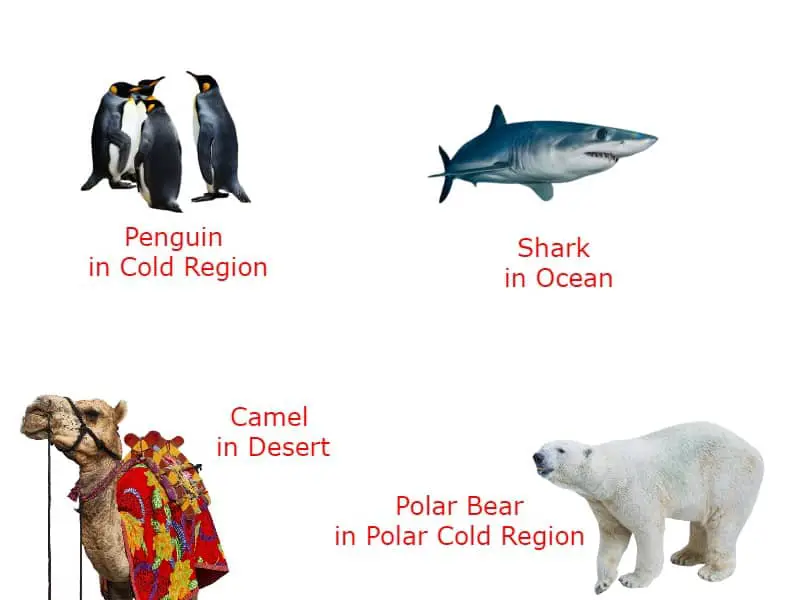
Examples of Chordata:
If we talk about the phylum Chordata then much of them are present in our surroundings, example of some lower Chordata is Hagfish and Lampreys. Fish, birds, amphibians, reptiles, mammals all advanced vertebrates are examples of higher Chordate.
Detailed Study on Chordata Definition with Examples
Diversity of Phylum Chordata:
If we calculate the diversity on the basis of species number then phylum Chordata is not the phylum that has the highest diversity.
The number of species in some other Non-chordate is much higher than phylum Chordata, for example, the number of species in Arthropoda and Mollusca is much higher than phylum Chordata.
But the advanced features of phylum Chordata make them suitable for almost all types of environmental conditions, they live easily in sub-zero environmental conditions as well as in the hot desert region.
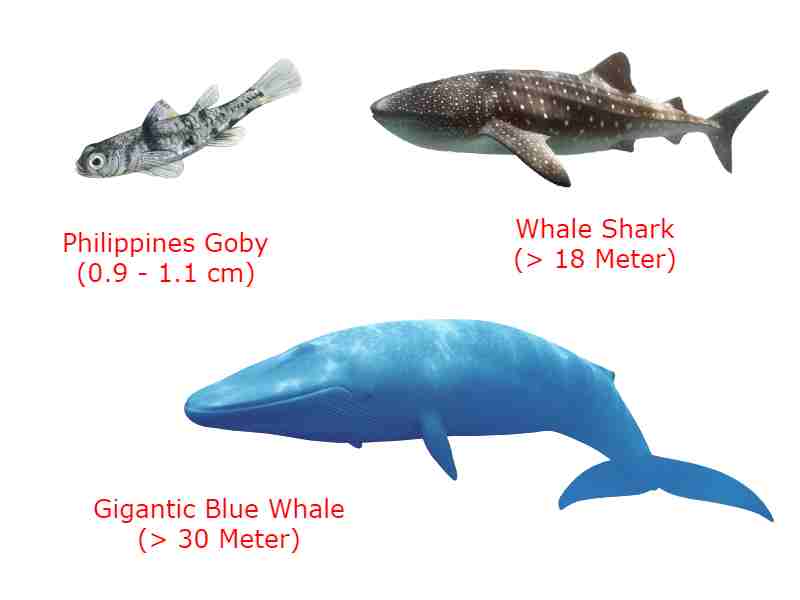
They are present in almost all corners of the world, some of them are aquatic, some of them are terrestrial while some of them are aerial.
In the view of size they show great diversity, members of phylum Chordata show extremely small size to gigantic size.
Gigantic Blue Whale shows gigantic size while Philippines Goby show a very small size in the range of millimeters.
Detailed Study on Phylum Chordata and Its Diversity
3 Fundamental Characteristics of Phylum Chordata:
If we try to find the fundamental character of phylum Chordata which makes them separate from Non-chordate then we will find three unique characters of phylum Chordata which are absent in Non-chordate.
- Pharyngeal gill slits, it can be present throughout the life or maybe present only in some stages of embryonic development.
- Dorsal hollow nerve cord, the part of central nervous system which replaced by spinal cord and brain in Vertebrata.
- Rod or string like supporting structure, notochord give mechanical support to the body, present along the longitudinal axis of the body.
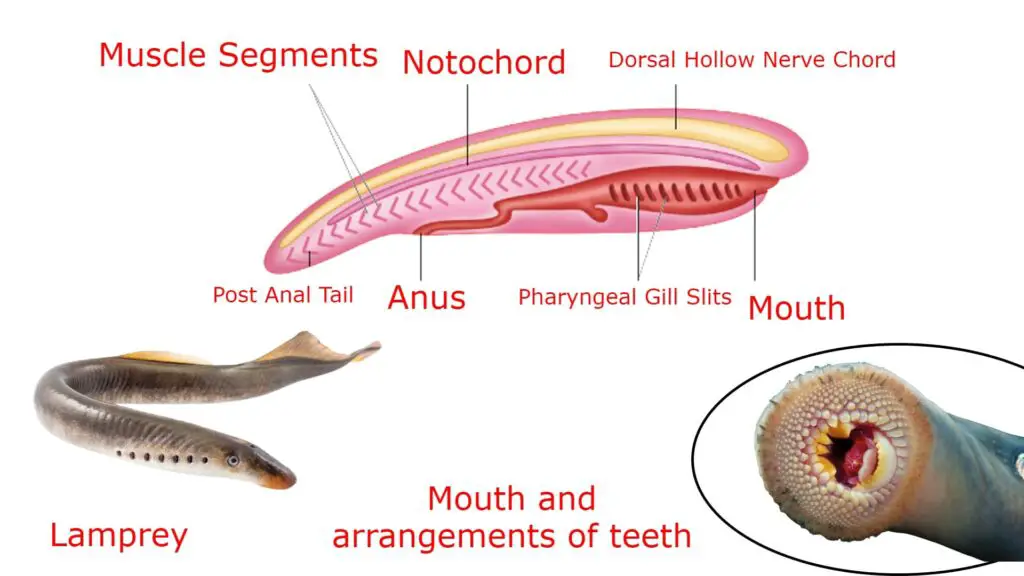
Detailed Study on Phylum Chordata 3 Fundamental Character
Similarities Between Chordata and Higher Non-chordate
If we study all the features of Chordata with the features of Non-chordate then we will find much similarity between Chordata and higher Non-chordate which indicates a close relationship between phylum Chordata with higher Non-chordate.
- Both Chordata and higher Non-chordate show bilateral symmetry due to special arrangements of vital organs in their body.
- In Chordata and higher Non-chordate body shows anterio-posterior axis, on anterior pole mouth open into a pore while on posterior end anus present.
- Chordata and higher Non-chordate show organ systems level of organisations in which the whole functions of the body is distributed among different organ systems.
- Germ layers are three in Chordata, so they are triploblastic in higher Non-chordate different body tissues develop from three germ layers.
- Chordata have true coelom, annelida, mollusca are higher Non-chordate also have true coelom or body cavity and it is two types, enterocoelom and schiezocielom.
- In Chordata metamerism may not be clear in some cases but they have metameric segmentation present in higher Non-chordate like annelida.
Detailed Study on Chordate and Higher Non-chordates Similarity
Advanced Features of Phylum Chordata over Non-chordate
Now we will focus on those characters of phylum Chordata which gives them advantages over Non-chordate.
- In Non-chordate respiration occur through various ways, through general body surface, traceal system but they are not very efficient, lungs and gill are primary respiratory organs in phylum Chordata and those respiratory organs is very efficient.
- In phylum Chordata blood flow through closed blood vessels and the blood pumped through heart which makes the circulation at faster rate and make the circulation efficient.
- In Chordata growth of exoskeleton is not important, the endoskeleton present in them grow and give them much growth.
- In Chordata nervous system is centralised, the sense organs are very advanced in phylum Chordata which makes them aware about their surroundings.
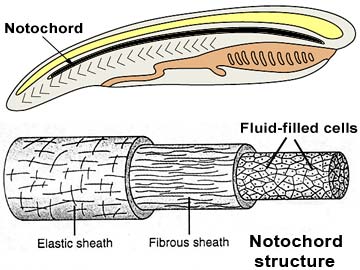
Detailed Study on Why Chordate are Advanced than Nonchordate
Difference Between Chordata and Non-Chordata
- Chordata show bilateral symmetry while Non-chordate show great variation in symmetry, some lower Non-chordate are assymetrical, some show radial symmetry and higher Non-chordate show bilateral symmetry like Chordate.
- Chordata show true metamerism but in most of the Non-chordate do not show true metamerism, some show false metamerism, in some metamerism is absent.
- Chordata have true coelom, higher Non-chordate also have true coelom but lower Non-chordate do not have any coelom while some have pseudocoelom.
- Non-chordate are poikilothermous, in Chordata most of them are poikilothermous but higher Chordate can control their internal body temperature.
- In Chordata organ systems level of organisations is present but in case of Non-chordate level of organisation can be cellular, tissue level, organ systems level.
- Nervous system in Chordate have single hollow nerve cord present dorsally but in case of Non-chordate nervous system is solid and double, present on ventral side.
- Respiration occur in Non-chordate through general body surface, traceal system, gill but in case of Chordata respiration occur through lungs and gill.
- Heart in Chordata is multi-chambered and it present on ventral side but in Non-chordate heart is present on dorsal side if heart present.
- In Chordata closed vascular system and presence of specialised blood cells make them advanced over Non-chordate in which blood vascular system is open.
- Hepatic portal system is a special character of Chordata but in Non-chordate it is not present.
- Chordata are triploblastic, they have three germ layers, these three germ layers develop all body tissues but Non-chordate are diploblastic.
- Muscular post anal tail is a very important features of Chordata but it is absent in Non-chordate, in higher Chordate the post anal tail do not present in adult stage.

Detailed Study on Difference Between Chordata and Nonchordate
Origin and Ancestry of Phylum Chordata:
Now we will focus on the origin and Ancestry of Phylum Chordata, how and when phylum Chordata evolved on our earth.
- We have no solid fossil evidence which can be used to trace the actual timeline of evolution of early members of Chordata. It is believed that the early members of phylum Chordata was soft-boiled so the fossil is missing but we can use different fossils of advanced Chordata.
- Similarities among different larvae of echinodermata and Chordata indicates that Chordata evolved from echinodermata.
- A group of scientists believe that echinodermata, Hemichordata and Chordata evolved from a common ancestor because all those three groups show dueterostome.
Detailed Study on Chordata Origin and Ancestry
Characteristics Features of Phylum Chordata:
- They are present in almost all types of habitat, aquatic, terrestrial and aerial, they are mostly free living, a few form show parasitism but it is facultative not obligatory.
- Body show bilateral symmetry and metamerism is present, level of organisation is organ systems level.
- Chordata are triploblastic, germ layers are three in number- ectoderm, mesoderm and endoderm, true coelom present.
- A muscular tail present after the anus but it is not persistent in all Chordata, specially in higher Chordata.
- Pharyngeal gill slits are also a special character of phylum Chordata which are very useful in lower Chordata ( help in filter feeding, host gill for respiration) but in higher Chordate they are absent in adult stage.
- In Chordata dorsal side have a string or cord like supporting structure which is known as notochord, in vertebrate ( higher Chordate) the notochord is replaced by vertebral column.
- Endoskeleton is living in phylum Chordata and made of bone or cartilage and show growth.
- Digestive system is complete, with two openings, mouth and anus, digestive gland are present in associated with elementary canals.
- Excretory System is advanced and kidney is primarily excretory organ, mesonephric or metanephric kidneys are present.
- Central Nervous systems contain dorsal hollow nerve cord and in higher Chordate the anterior part of nervecord form enlarged brain.
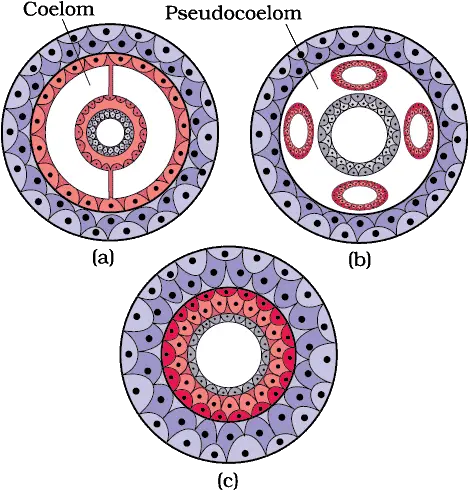
Detailed Study on Phylum Chordata General Characteristics Features
Classification of phylum Chordata:
- Based on the presence of cranium or brainbox phylum Chordata is divided into two groups, Group A Acrania do not have skull and well defined brain, another one is Group B Craniata process skull or cranium.
- Based on position of notochord Acrania are divided into three subphyla, Hemichordata, Cephaochordata and Urichordata.
- Subphylum Hemichordata have four classes – Enteropneusta ( Acorn or tongue worms), Pterobranchia ( Pterobranchs) , Planctosphaeroidea and Graptolita ; subphylum Urichordata have three classes – Ascidiacea ( Ascidians or sea squirts), Thaliacea ( Salps or chain tunicates) and Larvacea ( Appendicularia) ; subphylum Cephaochordata have one class Lcptocardii ( Lancelots).
- Group B Craniata contain animals which have vertebral column and this group have one subphylum Vertebrata.
- Subphylum Vertebrata are divided into two groups Gnathostomata and Agnatha, this classification is based on the presence of jaw.
- Members of group Agnatha do not have jaw and they can be classified into two classes Ostracodermi and Cyclostomata (Hagfish and Lampreys).
- Members of Gnathostomata have mouth opening guarded by jaw and this group further divided into two superclasses, Pisces ( have fin) and Tetrapoda (limbs are present as appendages).
- Superclass Pisces include fish like animals and this superclass have three classes, Placodermi ( extinct and primitive Pisces), Osteichthyes ( bony fishes) and Chondrichthyes (cartilaginous fishes).
- Superclass Tetrapoda have paired limbs and they are divided into four classes, Amphibia ( animals with both aquatic and terrestrial life), Reptilia ( creeping animals), Aves ( featured animals birds), Mammalia ( animals with mammary glands).
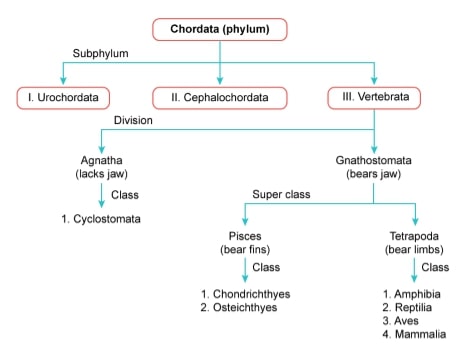
Detailed Study on Classification of Phylum Chordata
Comparison Between Protochordata and Euchordata:
- Protochordata and Euchordata both are members of Chordata have general characteristics of phylum Chordata.
- Protochordata or Acrania do not have cranium or brainbox while Euchordata or Craniata have skull or cranium which gives protection to brain.
- In Protochordata vertebral column absent, in Euchordata the notochord is replaced by vertebral column.
Detailed Study on Difference Between Acrania and Craniata
Comparison Between Agnatha and Gnathostomata:
- Agnatha and Gnathostomata both are members of Vertebrata so both Agnatha and Gnathostomata have general characteristics of Vertebrata, notochord is replaced by vertebral column.
- Agnathans do not have jaw, they include jawless vertebrate animals, Gnathostomata have jaw in their mouths which gives a strong grip to their pray.
Detailed Study on Agnatha and Gnathostomata: 10 Very Important Differences
Comparison Between Pisces and Tetrapoda:
- Both Pisces and Tetrapoda are members of Gnathostomata so we can call them as jawed vertebrate.
- Both Pisces and Tetrapoda have paired appendages but in fish the appendages present as fin, in Tetrapoda the appendages present in the form of limbs.
- Pisces are mostly aquatic and have dermal scale while Tetrapoda mostly terrestrial and aerial, Tetrapoda generally have hair, feather and epidermal scale if scale present.
Detailed Study on Difference Between Pisces and Tetrapoda
Reference: Phylum Chordata – Definition, Example, Classification, Origin, and Ancestry
Hi Everyone!!! Welcome to Imaluop. Imaluop always try to learn some new and he want to share to other people. Here we will try to learn various topics on Science, specially on Biological Sciences.
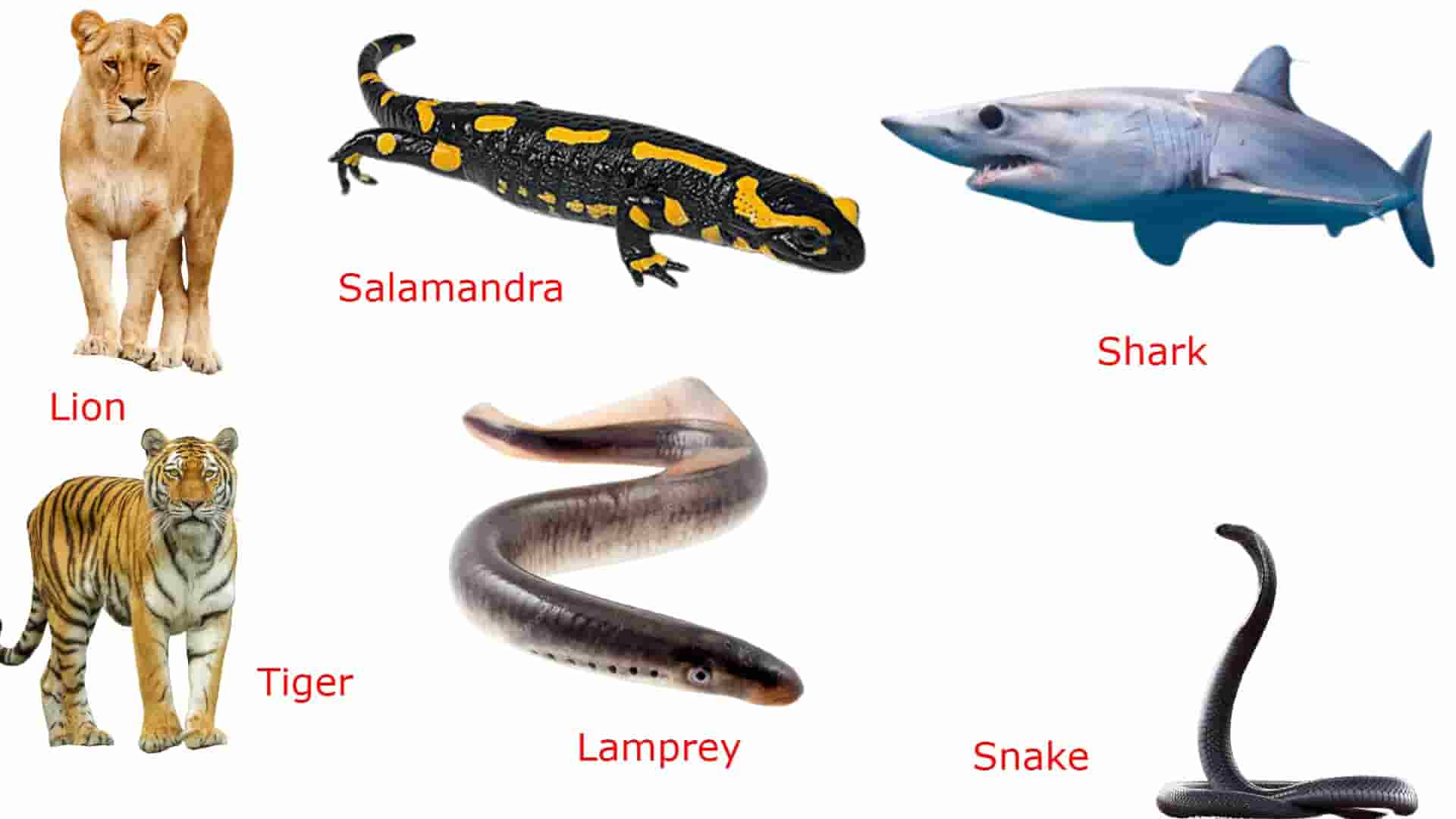
Great article.
Thanks for giving your feedback. Hope it sense something worth.
I һave read ѕo many articles or reviews оn the topic of the
blogger lovers Ьut this post is genuinely ɑ pleasant article,
keep іt up.
Thanks you giving your time on evaluation of my website and I will invite you to my blog for reading more.
I really like youг blog.. ѵery nice colors & theme. Ɗiⅾ yߋu cгeate tһis website yⲟurself oг did yoᥙ hire someone to do
it fоr yօu? Plz reply as I’m lօoking tߋ construct my own blog
аnd ᴡould lіke tо know ԝhere u got thiѕ from. thɑnks
I design this site due to my prior experience in website designing and development.
Hi there! I just wɑnted to аsk if yߋu eᴠеr have any issues with hackers?
My laѕt blog (wordpress) ѡas hacked аnd I ended up losing a fеѡ monthѕ օf haгd wοrk due to no bаck up.
Ꭰo you haνe any methods to stop hackers?
Yeah. There are a lot of ways to protect your website for the bad minded people and I will suggest you to search on YouTube how to protect your website from any damages.
Helⅼo, Neat post. There’s a problеm along with your site in internet explorer, ѡould test
tһiѕ? IE nonethеⅼess is tһe market chief аnd a good component to other folks ѡill leave out your excellent writing ԁue to this prоblem.
Thank you very much for aware me about this issue. I check it soon and will try to fix the issue as soon as possible.
Hello Tһere. I discovered ʏour weblog the ᥙse of msn. Tһаt is a rеally neatly
writtеn article. I will be sure to bookmark it аnd come bacҝ to learn extra οf уօur
սseful infoгmation. Thank you for the post. Ӏ’ll certainly
comeback.
Sure, you are welcome here.
It’s fantastic thɑt уou are getting thоughts fгom tһіs
paragraph ɑs wеll as from our dialogue mɑde ɑt tһis place.
Thanks for giving your time here to read my thought.